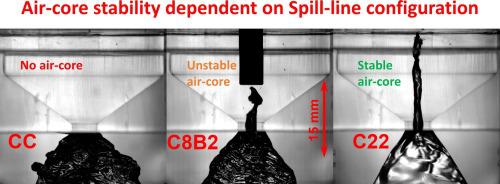当前位置:
X-MOL 学术
›
Exp. Therm. Fluid Sci.
›
论文详情
Our official English website, www.x-mol.net, welcomes your
feedback! (Note: you will need to create a separate account there.)
Internal flow dynamics of spill-return pressure-swirl atomizers
Experimental Thermal and Fluid Science ( IF 2.8 ) Pub Date : 2021-01-01 , DOI: 10.1016/j.expthermflusci.2020.110210 Milan Maly , Ondrej Cejpek , Marcel Sapik , Vladimir Ondracek , Graham Wigley , Jan Jedelsky
Experimental Thermal and Fluid Science ( IF 2.8 ) Pub Date : 2021-01-01 , DOI: 10.1016/j.expthermflusci.2020.110210 Milan Maly , Ondrej Cejpek , Marcel Sapik , Vladimir Ondracek , Graham Wigley , Jan Jedelsky

|
Abstract The sprays produced by spill-return pressure-swirl atomizers are strongly dependent on the nature of the internal fluid dynamics. Several spill-return atomizers were compared in terms of the spatial and temporal behaviour of the internal air-core, liquid sheet thickness and its perturbations. The only difference amongst the test configurations was the geometrical arrangement of the spill-line (SL) orifice through which the liquid was spilled away. The flow field inside the swirl chamber was examined using high-speed imaging with image post processing using an in-house Matlab code and three orthogonal velocity components acquired using Laser Doppler Anemometry. The dimensions of the production atomizers did not allow direct visualization of their internal flow, so a scaled, modular, transparent plexiglass model was used. Its flow characteristics were equivalent to the original atomizer. The refractive index of the atomizer body was matched to the test liquid using a solution of 1-Bromonaphthalene and kerosene fuel type JET A-1. The test conditions were derived from the original atomizer and were limited to inlet port Reynolds numbers, from 700 to 2000 and spill-to-feed ratios, SFR, from 0 to 0.75. An inviscid analysis, originally derived for Simplex atomizers, was modified and applied to the spill-return version. This approach allows a theoretical prediction of the discharge coefficient and air-core diameter dependent solely on SFR. An axially located SL orifice inhibits any internal air-core forming in the swirl chamber. Off-axial SL orifices generate and stabilize the air-core, which leads to the regular formation of a liquid sheet and a high-quality spray. Nevertheless, some configurations changed the breakup nature of the liquid sheet and consequently the spray quality. Moreover, the turn-down ratio of the liquid supply rate and spray stability depend on the distance of the SL orifices from the swirl chamber centreline. The flow energy losses increase with SFR. The outcomes from this analysis allow the optimization of the SL configuration for specific application and extend the classical inviscid analysis.
中文翻译:

溢流回流压力旋流雾化器的内部流动动力学
摘要 溢流回流压力旋流雾化器产生的喷雾强烈依赖于内部流体动力学的性质。在内部空气芯的空间和时间行为、液片厚度及其扰动方面比较了几种溢出返回雾化器。测试配置之间的唯一区别是溢出线 (SL) 孔口的几何布置,液体通过该孔口溢出。使用内部 Matlab 代码和使用激光多普勒测速仪获取的三个正交速度分量,使用高速成像和图像后处理来检查涡流室内的流场。生产雾化器的尺寸不允许直接可视化其内部流动,因此使用了缩放、模块化、透明的有机玻璃模型。其流动特性与原来的雾化器相当。雾化器主体的折射率与使用 1-溴萘和煤油燃料类型 JET A-1 的溶液匹配的测试液体。测试条件源自原始雾化器,并限于入口雷诺数,从 700 到 2000 和溢出与进料比,SFR,从 0 到 0.75。最初为 Simplex 雾化器派生的非粘性分析被修改并应用于溢出返回版本。这种方法允许对仅依赖于 SFR 的放电系数和空心直径进行理论预测。轴向定位的 SL 孔口可防止在涡流室中形成任何内部空心。离轴 SL 孔口产生并稳定空气芯,从而导致液体层的规则形成和高质量的喷雾。然而,一些配置改变了液体片的破碎性质,从而改变了喷雾质量。此外,液体供应速率和喷雾稳定性的调节比取决于 SL 孔口与涡流室中心线的距离。流动能量损失随 SFR 增加。该分析的结果允许针对特定应用优化 SL 配置并扩展经典的无粘性分析。
更新日期:2021-01-01
中文翻译:

溢流回流压力旋流雾化器的内部流动动力学
摘要 溢流回流压力旋流雾化器产生的喷雾强烈依赖于内部流体动力学的性质。在内部空气芯的空间和时间行为、液片厚度及其扰动方面比较了几种溢出返回雾化器。测试配置之间的唯一区别是溢出线 (SL) 孔口的几何布置,液体通过该孔口溢出。使用内部 Matlab 代码和使用激光多普勒测速仪获取的三个正交速度分量,使用高速成像和图像后处理来检查涡流室内的流场。生产雾化器的尺寸不允许直接可视化其内部流动,因此使用了缩放、模块化、透明的有机玻璃模型。其流动特性与原来的雾化器相当。雾化器主体的折射率与使用 1-溴萘和煤油燃料类型 JET A-1 的溶液匹配的测试液体。测试条件源自原始雾化器,并限于入口雷诺数,从 700 到 2000 和溢出与进料比,SFR,从 0 到 0.75。最初为 Simplex 雾化器派生的非粘性分析被修改并应用于溢出返回版本。这种方法允许对仅依赖于 SFR 的放电系数和空心直径进行理论预测。轴向定位的 SL 孔口可防止在涡流室中形成任何内部空心。离轴 SL 孔口产生并稳定空气芯,从而导致液体层的规则形成和高质量的喷雾。然而,一些配置改变了液体片的破碎性质,从而改变了喷雾质量。此外,液体供应速率和喷雾稳定性的调节比取决于 SL 孔口与涡流室中心线的距离。流动能量损失随 SFR 增加。该分析的结果允许针对特定应用优化 SL 配置并扩展经典的无粘性分析。











































 京公网安备 11010802027423号
京公网安备 11010802027423号